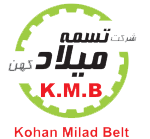Power transmission belt and its applications
The power transmission belt is known as an important and vital tool in the industry. The task of this tool is to transfer power from one part to another. These belts are made in different materials such as plastic and metals and their location is on the money. V-belts, timing belts, grooved belts, and round belts are just some of the different types of power transmission belts.
It is a producer of various types of power transmission belts in the best quality. In this article, we try to examine the components and performance of power transmission belts. Follow us until the end of the article to learn about this topic.
Power transmission belt, a vital tool in industry and mechanics
Power transmission belts are used in various industries for power transmission and movement of machines, industrial equipment, elevators, cars and various devices. It should also be said that these types of tools have special capabilities, that power transmission with minimal friction is only a part of these capabilities. Note that the cost of installing and maintaining the power transmission belt is very low. It will also be easy to install.
Power transmission belt components
The power transmission belt consists of several different components, each of these components has an important role in the efficiency and performance of the belt. In this section, we try to introduce the components of this tool separately.
Structural materials
Power transmission belts are usually made of different materials such as rubber, metal or fabric. The presence of these materials will increase the flexibility, high resistance and strength of the belt.
reinforcing substrate
Some belts have a reinforcing bed, which is made of steel or composite fibers. The reinforcing bed is used to increase the strength and strength of the belt.
The protective layer of the power transmission belt is made of various materials such as neoprene and plastic. The protective layer of the belt is used to protect it against moisture, corrosion and wear.
Welding joints
Welding of joints plays a very important role in the strength and useful life of the power transmission belt.
Types of power transmission belts
Power transmission belts are produced in different types, each of which has a special application. V-belts, round belts, timing belts and flat belts are just a few of the types of power transmission belts. In the following, we will provide information about each of these belts and their applications.
Grooved belt
Grooved belt is a type of power transmission belt that has deep and regular grooves on its surface. This type of belt is made of polyvinyl chloride or rubber and is used as a means of power transmission in machines.
Trapezoidal belt
V-belts are very common these days. The efficiency of these types of belts reduces the length of the contact arc in the pulleys. Also, the increase in transmission speed is the result of using trapezoidal belts. It should also be said that one of the advantages of using a trapezoidal belt is preventing damage to the engine as well as the device’s bearing.
round belt
As it is clear from the name of the round power transmission belt, its shape is circular. High resistance is one of the most important advantages of using this type of belts. Round belts are used in the production of devices such as movie projectors, agricultural tools, and sewing machines.
toothed belt
Toothed belt is another type of belt that, as its name suggests, has small and regular teeth on its surface. The presence of these teeth on the surface of these types of belts has caused power transmission with high accuracy. It should also be said that this type of belt is widely used in various industries due to its non-slip and resistance to pressure and tension.
Timing power transmission belts
Timing power transmission belts are made of rubber and have a very high resistance to dust, grease and moisture. These types of belts are very similar in appearance to flat belts. The only difference between timing belts and flat belts is the presence of fine teeth on the timing belts.
Benefits of using this tool
Using a power transmission belt has many advantages. These types of belts require little lubrication and their rotation speed is very high. Low energy consumption and high useful life are another part of the advantages of using this tool. Note that the use of power transmission belts produces very little noise and vibration compared to other transmission methods. It should also be said that this tool is very easy to install and has a low maintenance cost. Pars Khurshid Industrial Company is known as the producer and supplier of the best power transmission belts. Providing services as soon as possible is one of the most important benefits of working with this prestigious group.
Types of power transmission belt covers
Pay attention to the fact that power transmission belt cover is produced and supplied in different types. Each of these coatings is used in certain industries. Urethane coating, polyester coating, neoprene coating and rubber coating are known as the most important coatings of power transmission belts. For example, neoprene covers are used in various industries and have very high resistance and flexibility. Polyester coating is also used in printing and packaging industries.
The effect of power transmission belt in improving the performance of industrial and mechanical systems
The power transmission belt plays a very important role in improving the performance of mechanical and industrial systems. These types of tools have important characteristics such as low noise and flexibility, and relying on these characteristics, they can transfer power from one part to another with high accuracy. By using belts, energy is transferred more efficiently and less energy will be used to perform various tasks. Finally, we must say that using power transmission belts reduces pressure and wear between different parts of the system. This will ultimately increase the useful life of the device.

